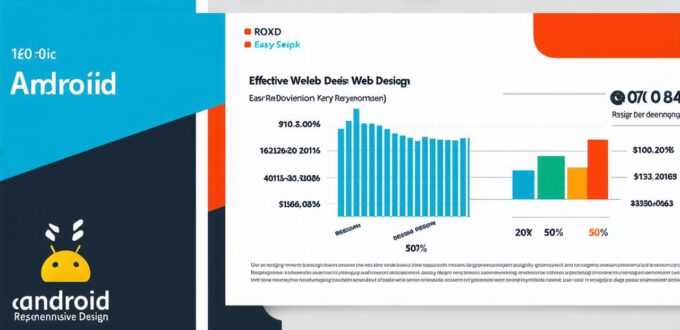In today’s fast-paced digital world, creating an effective and successful mobile application is crucial for any business or organization. With the increasing popularity of smartphones, many users are turning to Android devices for their mobile needs. As a result, it has become essential for app developers to optimize their workflow by leveraging the power of web design to create engaging and user-friendly apps. In this article, we will explore how effective web design can help optimize Android app development and attract more users to your app.
Understanding the Importance of Web Design in App Development
Web design plays a crucial role in app development as it determines how users interact with your app. Effective web design can help create a user-friendly interface that is easy to navigate, intuitive, and visually appealing. By optimizing web design elements such as layout, typography, color schemes, and images, you can create an app that stands out from the competition and provides a better user experience.
Case Studies: Examples of Effective Web Design in Android App Development
Several companies have successfully implemented effective web design in their Android app development process, resulting in increased user engagement and downloads. One such example is Airbnb, a popular accommodation booking platform that has an Android app optimized for web design. The app’s interface is user-friendly, with clear typography, high-quality images, and intuitive navigation. This approach has helped Airbnb reach a wider audience, including users who may not have access to the iOS version of the app.
Another example is Dropbox, a cloud storage service that also has an Android app optimized for web design. The app’s interface is simple and easy to use, with clear calls-to-action and a seamless user experience. This approach has helped Dropbox attract more users to its Android app, resulting in increased downloads and revenue.
Optimizing Web Design Elements for Effective Android App Development
To optimize web design elements for effective Android app development, developers should focus on the following key areas:
-
Layout: A well-designed layout is essential for creating an engaging and user-friendly interface. Developers should use a consistent layout throughout the app, with clear navigation menus and intuitive buttons. They should also ensure that the app’s content is displayed in a way that is easy to read and understand, with appropriate font sizes and spacing.
-
Typography: Typography plays a crucial role in creating an engaging and user-friendly interface. Developers should choose a typography that is legible and easy to read, with appropriate font sizes and spacing. They should also use contrasting colors for text and background to improve readability.
-
Color Schemes: Color schemes can have a significant impact on the user experience of an app. Developers should choose a color scheme that is visually appealing and consistent throughout the app. They should also ensure that the color scheme is optimized for different screen sizes and resolutions, with appropriate contrasting colors.
-
Images: Images play a crucial role in creating an engaging and user-friendly interface. Developers should use high-quality images that are optimized for different screen sizes and resolutions. They should also ensure that the images are used appropriately throughout the app, with clear calls-to-action and appropriate spacing.
-
Responsive Design: Responsive design is essential for creating an app that adapts to different screen sizes and resolutions. Developers should use responsive design techniques such as flexible grids, media queries, and fluid images to create an app that provides a seamless user experience across multiple devices.
Comparing Traditional App Development vs Effective Web Design
Traditional app development and effective web design have several key differences. Traditional app development requires developers to create separate versions of the same app for each platform, which can be time-consuming and expensive. In contrast, effective web design involves creating an app that can be accessed through a web browser on any device, eliminating the need for separate versions of the same app.
Effective web design also provides a wider reach as it is accessible to all users with an internet connection, regardless of their device type or platform. Traditional app development, on the other hand, is limited to specific platforms and devices, which can limit its reach.
In addition, traditional app development requires developers to have expertise in multiple programming languages, while effective web design only requires knowledge of HTML, CSS, and JavaScript. This makes effective web design more accessible to developers who may not have the same level of expertise in multiple programming languages.
FAQs: Frequently Asked Questions about Effective Web Design in Android App Development
Q: What is the difference between traditional app development and effective web design?
A: Traditional app development involves creating separate versions of the same app for each platform, while effective web design involves creating an app that can be accessed through a web browser on any device.
Q: Which approach is more cost-effective and efficient?
A: Effective web design is more cost-effective and efficient as it eliminates the need to develop separate versions of the same app for each platform.
Q: What are some examples of effective web design in Android app development?
A: Airbnb and Dropbox are two examples of companies that have successfully implemented effective web design in their Android app development process.
Conclusion: The Benefits of Effective Web Design in Android App Development
In conclusion, optimizing web design elements is crucial for creating an engaging and user-friendly Android app. By using responsive design techniques, developers can create an app that adapts to different screen sizes and resolutions, providing a seamless user experience across multiple devices. Effective web design also provides a wider reach as it is accessible to all users with an internet connection, regardless of their device type or platform. By implementing effective web design in their Android app development process, developers can attract more users, increase engagement, and drive revenue growth for their business or organization.
